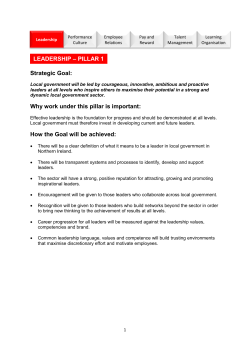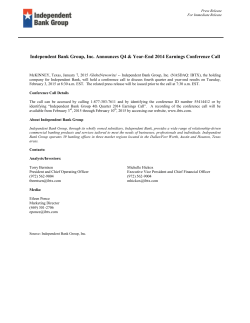
1Q2015 Shareholder Letter
April 14, 2015 Dear Azzad Funds Shareholder, Volatility continued to rule the domestic equity markets in the first quarter. After losing ground in January, the major indices had a strong February. March saw early losses, then solid gains, with the Dow industrials, S&P 500, and Russell 2000 all hitting closing highs, and the Nasdaq closing above 5000 for the first time in 15 years, just shy of its all-time high. But these gains were tempered by a late-month downturn, with all the major indices losing ground in five of the last seven trading days as investors, jittery about corporate earnings, took profits. The Russell 2000 small caps, which are seen as having less international exposure, led all indices for the quarter, up almost 4%, with the Nasdaq right behind at 3.5%. The S&P and Global Dow trailed, up 0.4% and 0.7% respectively, while the Dow industrials slipped into negative territory for the year. The Fed's slower-than-expected approach to interest rate hikes caused a sharp but temporary drop in the U.S. dollar, which continued to gain strength during the quarter against the currencies of its major trading partners. While a strengthening dollar was good news for Americans traveling abroad, it added to investor angst because of the potentially adverse effects on the global profits of U.S. multinational corporations. Lower gas prices boosted consumers' spending power during the quarter, but the sharp declines also raised questions about whether prices would fall so far that energy companies would cut back on jobs and/or ongoing operations. Even escalating tensions in the Middle East caused only a temporary spike back over $50, with U.S. spot crude prices closing the quarter under $48 a barrel. Azzad Ethical Fund (ADJEX) The Azzad Ethical Fund returned 4.63% during the first quarter of 2015, trailing the 5.38% return of the Russell Midcap Growth Index. Midcap growth stocks were among the best performing sectors in U.S. equities, benefiting from lower earnings growth prospects for the broader market in 2015. Some of the Fund’s holdings lowered their earnings outlooks, as a strong dollar reduced the value of their profits in foreign markets. This dynamic was pronounced in our retail sector names, where those with significant overseas operations lagged their domestic-focused peers. The strong dollar also hurt the forecasts of several of our consumer durable and apparel holdings. Holdings in the volatile biotech and pharma sector performed well over the three months, but did not keep up with the industry overall. Our stock picking in the automobile industry was helped by the impressive operating results from component makers. We were also able to outpace the performance of a hot semiconductor sector. While we were correctly underweight the materials sector, our names there more than doubled the industry’s performance. The Fund remains underweight the energy sector, though signs of stabilization started to appear this quarter. Weakness in energy prices also keeps us underweight the capital goods industry, for which the energy sector is a key customer. The Fund remains overweight health care, where we believe that value can still be found in many equipment and services names. We remain optimistic about the U.S. economy and have seen signs of an increasingly confident consumer and rebounding growth going into the Spring. We believe the Fund is likely to benefit from these dynamics. Azzad Wise Capital Fund (WISEX) The Azzad Wise Capital Fund returned 0.50% for the quarter, underperforming the benchmark BofA Merrill Lynch US Corporate and Government Master Index, which returned 0.59%. This performance was led by our holding of the Emaar Malls 2024 Sukuk, which contributed 18 basis points to the total return. Elsewhere in the region, Dubai Islamic Bank Tier 1 Perpetual Sukuk, Saudi Electric 2024 Sukuk, and Qatar Telecom 2018 Sukuk each contributed a respective 12 basis points, 9 basis points, and 9 basis points to return. Despite the low oil price environment and recent GCC military action in Yemen, the performance of these and other Middle Eastern names in the portfolio has been that of a highly rated liquid and fundamentally robust region, with large fiscal buffers to absorb the drop in oil revenues. Although we do not discount the fact that the conflict in Yemen could escalate with the introduction of ground forces, we have no direct or indirect exposure to Yemen in the portfolio, and we remain vigilant with respect to any adverse reactions elsewhere. Beyond the Middle East, the Fund’s holding of the Indonesian government sukuk contributed 13 basis points this quarter. Indonesia has benefitted from the low oil price environment, which has resulted in a declining current account deficit, now forecast to go from 3% of GDP in 2014 to 2.4% of GDP in 2015, and the ability to conduct lasting fiscal reforms of energy subsides. With government plans to spend fiscal revenues on investment and infrastructure, economists are predicting real GDP growth to tick up from 5% in FY2014 to 5.3% in FY2015. Over the quarter, we significantly reduced our interest rate exposure, from a duration of 1.82 years to a current 1.38 years. In preparation for an anticipated U.S. rate hike later in the year, we took the view that it would be prudent to reduce our interest rate risk early since an adjustment later in the year could become more painful as more market participants look to do the same. Thank you for your continued trust and investment in the Azzad Funds. Jamal Elbarmil Vice President and Portfolio Manager The performance quoted represents past performance, which does not guarantee future results. This summary represents the views of the portfolio manager as of March 31, 2015. Those views may change, and the Funds disclaim any obligation to advise investors of such changes. The Azzad Funds are self-distributed and available by prospectus only. A free copy of the prospectus, which contains information about the Funds’ risks, fees, and objectives, and other important information, is available at www.azzadfunds.com or by calling 888.350.3369. The Dow Jones Industrial Average (DJIA) is a price-weighted index composed of 30 widely traded blue-chip U.S. common stocks. The S&P 500 is a market-cap weighted index composed of the common stocks of 500 leading companies in leading industries of the U.S. economy. The NASDAQ Composite Index is a market-value weighted index of all common stocks listed on the NASDAQ stock exchange. The Russell 2000 is a market-cap weighted index composed of 2,000 U.S. small-cap common stocks. The Global Dow is an equally weighted index of 150 widely traded blue-chip common stocks worldwide. Market indices listed are unmanaged and are not available for direct investment. The Bank of America Merrill Lynch US Corporate & Government Master Index tracks the performance of US dollar-denominated investment grade Government and Corporate public debt issued in the US Domestic bond market, excluding collateralized products. The Midcap Growth Index measures the performance of the mid cap growth segment of the U.S. equity universe. It includes those Russell Mid Cap Index companies with higher price to book ratios and higher forecasted growth values. The index is unmanaged and an investment cannot be made directly in this or any other index.
© Copyright 2025





















